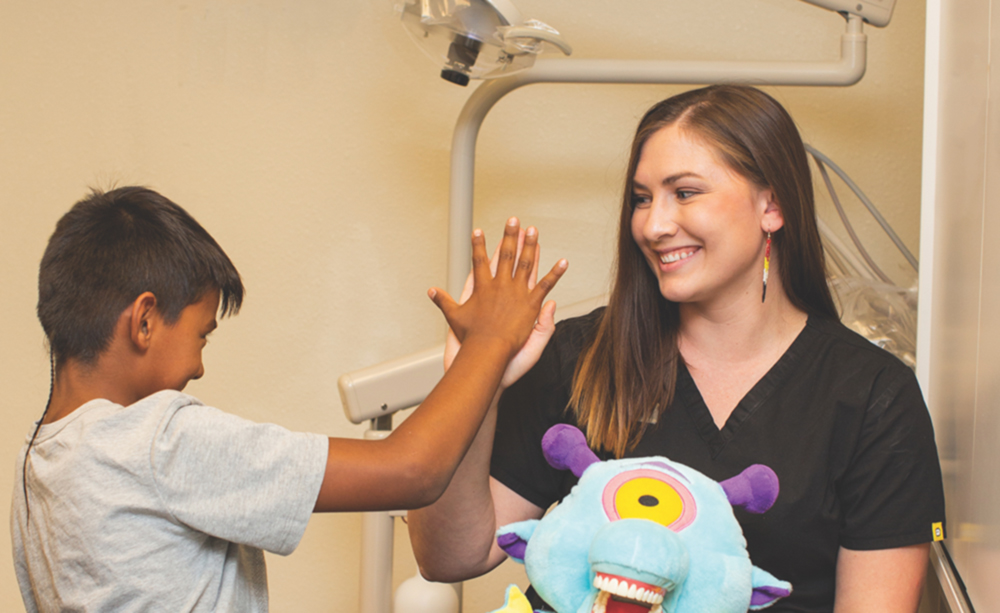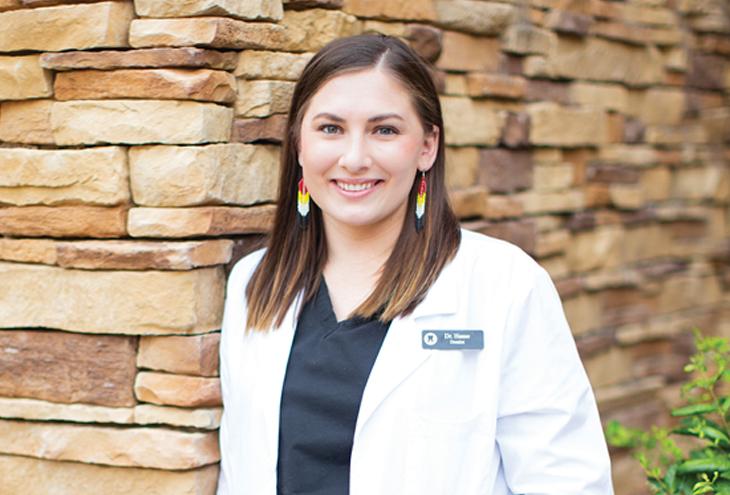When Cristin Haase was first thinking about a career in dental health, the inequality in care available to American Indians was on her mind — she wanted to be one of the few Indigenous professionals working on closing that gap. Looking at the options, she took to heart her grandmother’s urging that she should “go be the dentist.” As Dr. Haase says, “She pushed me to look at the horizon, not just what’s in front of me at the moment.”
Dr. Haase, Cheyenne River Sioux, grew up in the small town of Lidgerwood, N.D. In high school she was a star basketball player, earning All-State honors and leading the state’s high school scoreboard with points that averaged 21 per game. After graduating, she went to United Tribes Technical College in Bismarck, N.D., for a year, where her talent on the court took her to the First Team Mon-Dak Conference in 2010 and the Mon-Dak Conference All-Academic Team and All-Region XIII Basketball Team that same year. She still plays for fun, and recently participated in an all-Indian tournament.
Dr. Haase went on to complete her undergraduate degree in cellular and molecular biology at Fort Lewis College in Durango, Colo., and earned her doctorate from A.T. Still University’s Arizona School of Dentistry and Oral Health (ASDOH) in Mesa. She graduated last year with both a DMD and a master’s in public health and began working at Klamath Tribal Health and Family Services in Klamath Falls, Ore.
Throughout her studies, Dr. Haase followed her dream of achieving equal representation for American Indians in dental care. At one point she applied for, and ultimately received, a $10,000 grant from Running Strong for American Indian Youth, which she used to create a mentorship program to connect prospective American Indian dental students with current American Indian dental student mentors.
In 2016, Dr. Haase launched her first Pre-Admissions Workshop (PAW) for Native high school seniors and college students with an interest in dentistry careers. The three-day workshops include information on the importance of developing a support network, the application process, requirements of various dental schools, and study guides for taking the Dental Admissions Test. Students are also given hands-on training, like trying out dentistry skills, completing mock interviews, and learning how to effectively study and complete tests. Dr. Haase also includes information about AISES and AISES scholarships at her PAWs. (PAW applications are posted at atsu.edu/american-indian.)

“The process for applying to dental school has its own ins and outs,” explains Dr. Haase, “and we’re able to guide students through it. This will hopefully lead to increased numbers of American Indians becoming dentists, with at least some returning to work in their tribal communities, where they can help improve oral health and awareness among American Indians in need.”
According to Dr. Haase, American Indians are the most underrepresented population within the dental health profession. In fact, one of her mentors at ASDOH, Dr. George Blue Spruce Jr., Laguna and Ohkay Owingeh, is only the first American Indian dentist in the United States. While the American Indian population now numbers more than five million, according to the National Congress of American Indians, the American Dental Association estimated in 2012 that there are fewer than 500 Native dentists.
Additionally, says Dr. Haase, American Indians face the greatest oral health disparities in the nation, with a decay rate four times that of non-Hispanic whites, according to a 2014 Indian Health Service survey. These numbers only fortify Dr. Haase’s goal of influencing the number of American Indian students wanting to become dentists, and she has led two additional dental career–focused workshops with Running Strong grant funding. This past year, she returned as a PAW mentor.
Today, Dr. Haase sees patients of all ages, and performs an array of dental procedures. “The other day I had a young girl who needed a tooth extracted — it was really hurting her,” she says. “Once I removed the bad tooth, the patient felt so good she gave me a high-five. Now that was rewarding.”










